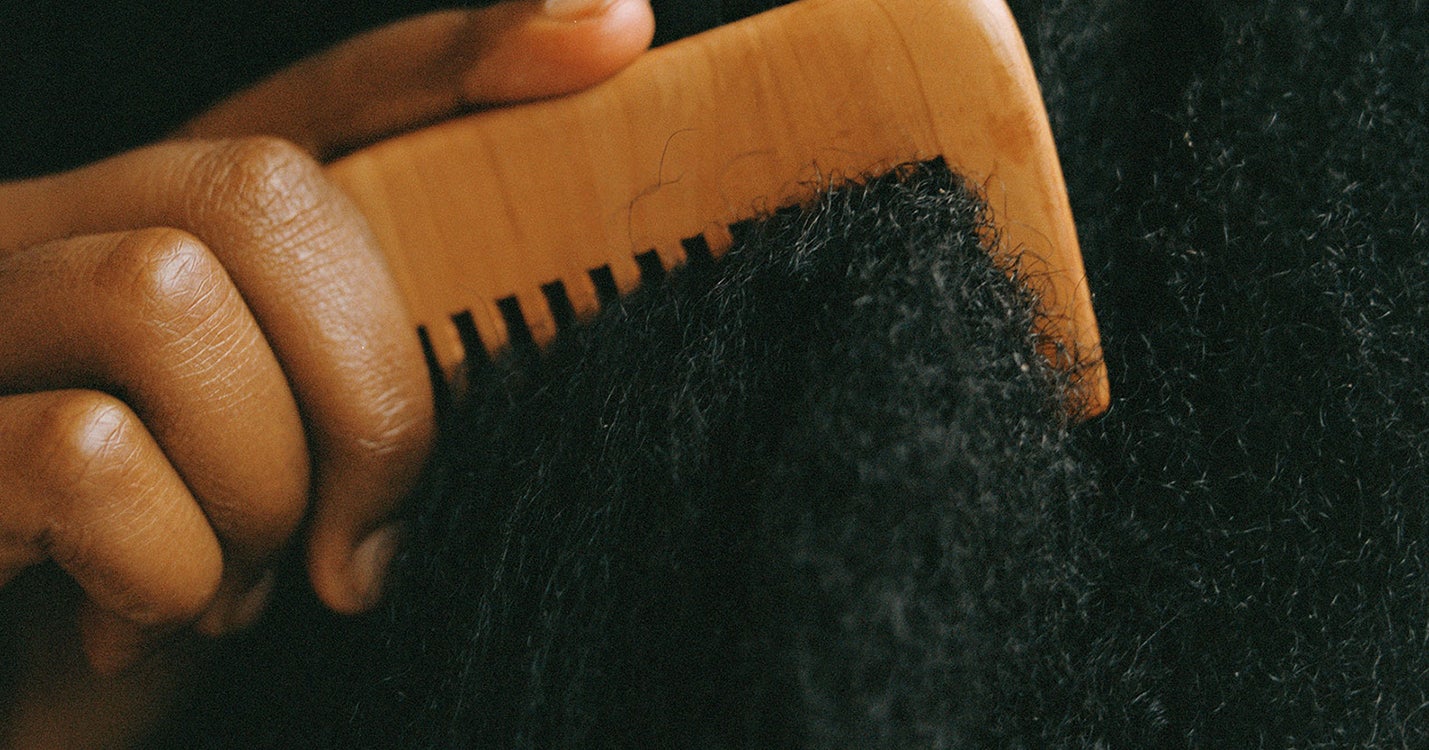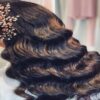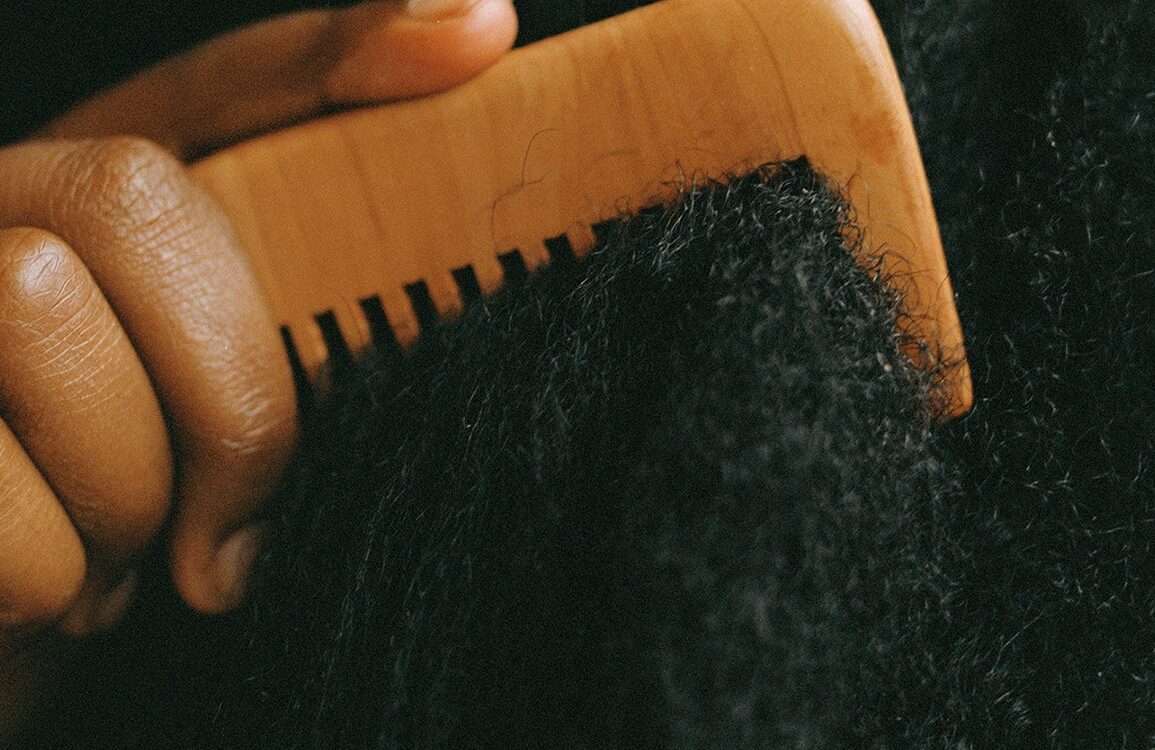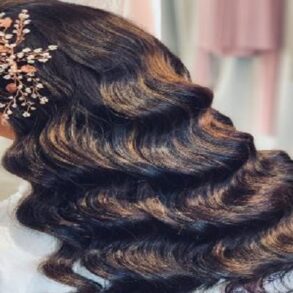
“Like many Black women, I tried numerous hair oils that promised hair growth but saw no benefits… with exhaustion, I gave up,” explains Amanda Cowham to Unbothered over email. “I had a bad sew-in [weave] experience that gave me bald patches due to inflammation and an allergic reaction. This prompted me to go to a doctor for thorough testing,” she says, sharing that she had been diagnosed with an overactive thyroid that provoked “inflammation and itching” leading to bald spots. The 30-year-old content creator from Zambia has been sharing her experiences with hair loss and hair growth on TikTok for over a year. Cowham is one of the many Black women dealing with hair loss and traction alopecia from tight braids and weaves and uses her platform to share hair growth methods that work. For Cowham, her results came via minoxidil: a medication that comes in a foam, solution or pill used to treat hair loss. The treatment, which is available over-the-counter without a prescription, is the one method she says has worked to restore her hair. And, from the looks of her videos, her thick curly hair is thriving. “ minoxidil has given me my confidence back,” she shares. “I now have a head full of hair — more hair than what I bargained for.”
Cowham’s not the only one boasting drastic results. There are over 25 million posts on TikTok of Black women sharing their experiences using minoxidil — including drastic before and after photos of fully restored edges and concealed bald spots. Out of all the so-called miracle hair growth cures aimed towards Black hair types on social media—from washing hair in rice water to TikTok’s favourite rosemary oil—minoxidil is touted as a science-backed alternative with measurable results. However, as with any hair product that claims radical hair growth, there’s room for scepticism and it’s always advised to approach any medication with caution and advice from a professional. The full picture reveals that buying Minoxidil is expensive, has side effects and online markets are rife with counterfeit products. Still, the impressive results seen on social media are driving considerable intrigue within Black haircare spaces (there are hundreds of Reddit threads stating that minoxidil is a ‘game-changer” for Black hair types). As many seek to purchase minoxidil, is this the best solution for Black hair loss?
What exactly is minoxidil and what is it used to treat?
In short, minoxidil is a medication that can come in a foam or solution to treat topically, applied directly to the affected area, or taken orally in a pill. As Refinery29 reported earlier this year, while there are countless stimulating oils and scalp scrubs out there, “the only proven topical hair growth treatment is minoxidil”. For those familiar with commercial products containing minoxidil, such as Rogaine, you may be thinking, “Isn’t minoxidil for male pattern hair loss only?” While popular amongst men seeking solutions for hair loss, minoxidil can be used to treat female pattern hair loss and hair thinning. “[Minoxidil works by] increasing blood flow to the follicle and decreasing hair shedding by prolonging the growing phase of the hair growth cycle,” explains Samantha Stewart MIT, Consultant Trichologist for supplement company Hair Gain, who confirms that minoxidil is “very safe” when treating some forms of female hair loss.
A dermatologist or GP can recommend minoxidil for those suffering from hair loss, yet it doesn’t need a prescription. However, not all forms of hair loss may require minoxidil or any treatment whatsoever. As the NHS explains, hair loss due to an illness, stress, cancer treatment, weight loss and iron deficiency may be temporary and not require intervention. The NHS stresses that no hair loss treatment is “100% effective” and many experts state that minoxidil is not a “cure”. Typically it takes two to four months for people to see new hair growth when using minoxidil, and people have to use the product indefinitely to maintain results — in simple terms some people lose the new hair growth once they stop using the medication.
It is also a significant commitment that can be expensive. On average, Regaine for women costs £35 for a two-month supply whereas, Rogain, containing a higher percentage of minoxidil, can cost around £55. In the UK, it’s worth noting that most hair loss treatments, including minoxidil, are not available on the NHS, so you’ll have to pay for them. Black hair products are already expensive — more expensive than products aimed at European hair — so committing to minoxidil means a weighty annual cost.
It was a commitment Cowham was happy to take on. After speaking to her doctor before treatment, the content creator has trialled both topical and pill forms.“I have been taking minoxidil for one year and one month now,” says Cowham. “I started with a prescription topical formulation before I switched to oral minoxidil. I did respond well to topical but preferred the ease of oral minoxidil.”
Can minoxidil help Black women dealing with traction alopecia?
It’s clear to see what’s driving the interest regarding minoxidil within the Black hair care space — the stigma of having “no edges” is a pervasive one. According to Carra Labs Textured Gap Report in 2023, hair loss is one of the biggest concerns amongst Black customers and it’s been estimated that up to a third and almost half of Black women have experienced hair loss in their lifetime. While some cases are genetic, such as alopecia areata and female pattern hair loss, many Black women are prone to traction alopecia — hair loss caused by the hair being pulled in the same way for a long time — due to tight, braided hairstyles and weaves that repeatedly pull on hair strands and lead to weakening the hair follicle causing hair loss. In some cases, this can be permanent. I know from personal experience the frustration that comes with trying to repair thinning edges and desperately waiting for results. Though not everyone dealing with traction alopecia may need to try a medication such as minoxidil.
“A medicated treatment such as minoxidil may not be necessary in the early stages of traction alopecia,” explains Stewart, “I would always recommend that the hair loss condition be examined by a trichologist first.” Stewart explains that if traction alopecia is caught early hair can regrow — although, this means re-thinking tight hairstyles that caused the issue in the first place and being vocal with your braider and hairstylist when tension is applied to the scalp. Recovery from traction alopecia depends on the “amount of damage” that has been caused to the hair follicles. “Once permanent damage has been caused, hair regrowth may not be possible,” Stewart says.
While using minoxidil isn’t for everyone, for Black women, like Cowham, the results are hard to deny. “[Using minoxidil] has given me a different outlook on beauty and self-care. I now dedicate my time to taking good care of my hair versus before I’d just put it in a protective style,” she says. “I also have learned to style my hair and spend good money on quality products that my hair will love. I have also learned to embrace my own hair along the way, finding gratitude in the little things I took for granted.”
@approvedhaircare Replying to @X ♬ BIG UP – INJI
Does minoxidil cause any side effects?
As mentioned, Cowham has been taking minoxidil in a pill form for more than a year — she also uses it topically. And, though she welcomes her full head of hair she admits that she has gotten ‘more hair than she bargained for” and now deals with excessive body hair. Because, well, minoxidil helps grow all hair.
Cowham also has complained of heart palpitations and “headaches that “have since gone away”. Cowham has not experienced any more setbacks, but the risk of side effects may inspire caution in others thinking of following a similar treatment plan.
“Like many medications, minoxidil has side effects that some people may suffer from if they use it,” says Stewart. Stewart suggests that using minoxidil topically — applied directly to the affected areas — sees “fewer potential side effects” but it is still something to consider and take seriously. ‘It is important to ensure that anyone considering using minoxidil makes themselves aware of these side effects before starting treatment.”
Scalp irritation and hair shedding are also common reactions to minoxidil. “Any of the ingredients in minoxidil can irritate. It is important to ensure that if you are using minoxidil daily, you wash your hair at least once or twice a week,” advises Stewart. “Minoxidil can also increase hair shedding when you first start using it, this tends to happen within the first two months after beginning use. This shed is due to minoxidil moving hairs from the resting phase into the shedding phase in preparation to start re-growing. This is only a temporary increase and should settle down within a few weeks.”
Those considering minoxidil should follow advice from a GP, trichologist or dermatologist and purchase over the counter in pharmacies. However, on social media, some have turned to online marketplaces, such as Amazon and eBay, that are rife with counterfeit products, further risking the health of your hair and scalp. “It’s really important that you buy a reputable brand that has clinical backing,” says Stewart. “It is not wise to buy from an unknown source off the internet. This could be a counterfeit product containing harmful substances.”
What are the alternatives to minoxidil?
Hair loss is an emotional issue as much as it is a physical one. I don’t have to explain this to anyone who has experienced it. Minoxidil appeals to those who have tried many other options and have seen no substantial results. But this isn’t the only option. For significant forms of hair loss, dermatologists and trichologists can use blood, DNA and strand testing to identify emotional, nutritional, hormonal, environmental and genetic factors affecting the health and condition of your hair and scalp. Depending on the scale and cause of hair loss, trichologists can suggest invasive (and expensive) treatments such as hair transplants, steroid injections, laser and light treatments, or trying supplements and learning new ways to care for your hair and scalp. But first, speak to your doctor, before you take this specific hair growth journey.
This post was originally published on this site be sure to check out more of their content.








